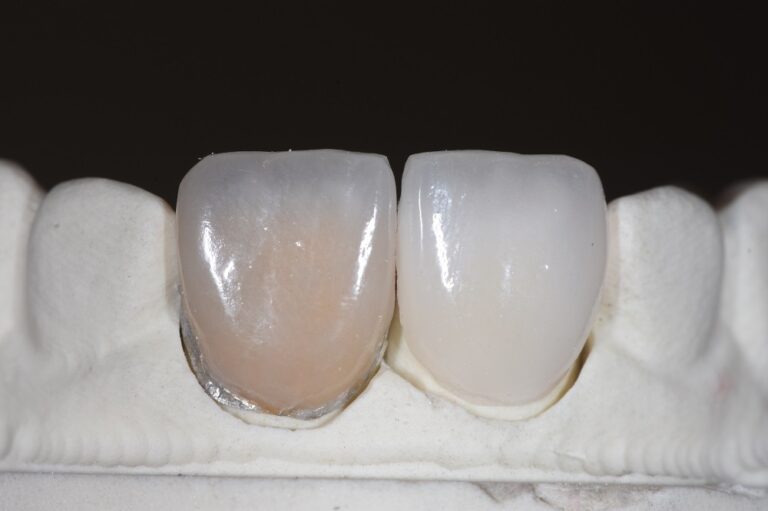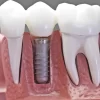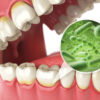- By - Malfaifi
- Posted on
- Posted in Dental Material
Ceramic materials and clinical recommendations
Current ceramic materials and systems with clinical recommendations: A systematic review
Heather J. Conrad et al 2007

- McLean pioneered the concept of adding Al2O3 to feldspathic porcelain to improve mechanical and physical properties.
- The first biomedical application of zirconia occurred in 1969. The first paper regarding the use of zirconia for the production of artificial femoral heads was written by Christel in 1988.
- The most commonly reported major clinical complication resulting in failure of all-ceramic restorations is the fracture of the veneering porcelain and/or the coping
- A minimum connector height of 3 to 4 mm from the interproximal papilla to the marginal ridge is a guideline for most systems.
- Contraindicated when there
- Reduced interocclusal distance
- Short clinical crowns
- Deep vertical overlap anteriorly without horizontal overlap
- Opposing supraerupted tooth
- Cantilevers
- Periodontally involved abutment teeth
- Patients with severe bruxism or parafunctional activity
- Failure in all ceramic – Connector fractures ( Aluminum oxide FPDPs and lithium-disilicate FPDPs) , Cohesive fracture of the veneering porcelain, for zirconia FPDPs.
- Main Failure in metal-ceramic – Tooth fracture and caries.
- The Law of Beams by maximizing connector height and width is the basis for the proper design of all-ceramic FPDs
- Enamel is 97% hydroxyapatite mineral matter, it is very translucent and able to transmit up to 70% of light. Dentin is also capable of transmitting up to 30% light.
Glass-ceramics
IPS Empress 2 (Ivoclar Vivadent)
- Is a lithium-disilicate glass ceramic (SiO2 -Li2O)
- Fabricated by the combination of the lost-wax and heat-pressed techniques.
- A glass-ceramic ingot of the desired shade is plasticized at 920°C and pressed into an investment mold under vacuum and pressure.
- Its predecessor, IPS Empress (Ivoclar Vivadent), is a leucite-reinforced glass ceramic (SiO2 -Al2O3 -K2O) which, due to its strength, is limited in use to single unit complete-coverage restorations in the anterior.
- IPS Empress 2 has improved flexural strength by a factor of 3 over IPS Empress, can be used for 3-unit FPDPs in the anterior area, and can extend to the second premolar.
- IPS e.max Press (Ivoclar Vivadent) was introduced in 2005 as an improved press-ceramic material compared to IPS Empress 2.
Alumina-based ceramics
- In-Ceram Alumina (VITA Zahnfabrik), introduced in 1989, was the first all-ceramic system available for single-unit restorations and 3-unit anterior.
- It has a high-strength ceramic core fabricated through the slip-casting technique.
- In-Ceram Spinell (VITA Zahnfabrik) was introduced as an alternative to the opaque core of In-Ceram Alumina. It contains a mixture of magnesia and alumina (MgAl 2 O 4 ) in the framework to increase translucency but lower flexure strength.
- In-Ceram Zirconia (VITA Zahnfabrik) is also a modification of the original In-Ceram Alumina system, with an addition of 35% partially stabilized zirconia oxide to the slip composition to strengthen the ceramic.
- Since the core is opaque and lacks translucency, the material is recommended for posterior crown copings and FPDP frameworks.
- Procera (Nobel Biocare AB, Goteborg, Sweden) was developed by Andersson and Oden with copings that contain 99.9% high-purity aluminum oxide.
- Procera has the highest strength of the alumina-based materials and its strength is lower only than zirconia.
Zirconia-based ceramics
- Zirconia is a polymorphic material that occurs in 3 forms.
- Cubic phase at its melting point of 2680°C
- Tetragonal phase below 2370°C.
- Monoclinic phase transformation occurs below 1170°C and is accompanied by a 3-5% volume expansion which causes high internal stresses.
- Yttrium-oxide (Y2 O3 3% mol) is added to pure zirconia to control the volume expansion and stabilize it in the tetragonal phase at room temperature.
- This partially stabilized zirconia has high initial flexural strength and fracture toughness.
- Tensile stresses at a crack tip will cause the tetragonal phase to transform into the monoclinic phase with an associated 3-5% localized expansion.
- Phenomenon “Transformation toughening and retards crack propagation” The volume increase creates compressive stresses at the crack tip that counteract the external tensile stresses.
- Chemical and dimensional stability, high mechanical strength, and fracture-toughness
- The framework structure has a linear shrinkage of 20-25% during sintering until it reaches the desired final dimensions.
- Milling fully sintered zirconia may compromise the microstructure and strength of the material.
- Lava
- (3M ESPE)
- Y-TZP framework with high flexural strength, high fracture toughness, and low elastic modulus compared to alumina and exhibits transformation toughening when subjected to tensile stress.
- Cercon (Dentsply Ceramco)
- requires conventional waxing techniques to design the Y-TZP framework, and the wax pattern is scanned.
- The first all-ceramic implant abutments (CerAdapt; Nobel Biocare AB) were made of densely sintered, high-purity alumina.
- Abutments are either customized through electronic data or are stock abutments that can be modified via conventional preparation.
- The success of many all-ceramic systems is dependent on the strength of a core-veneer bond.
- Zirconia-based ceramics are recommended for FPDPs, as they have the highest failure loads when compared to alumina- and lithium-disilicate-based ceramics.
- A lithium disilicate glass-ceramic IPS Empress 2 was found to be inappropriate for posterior FPDPs due to the high susceptibility of the veneer to subcritical crack growth and the absence of crack arresting at the core-veneer interface.
- Christensen reported the clinically detectable range for subgingival margins to be 34-119 μm and 2-51 μm for supragingival margins.
- Subsequently, McLean suggested that 120 μm should be the limit for clinically acceptable marginal discrepancies.
- Holmes 1989measured various points between the casting and the tooth and clarified the terminology for misfit.
- The probe cannot accurately reproduce proximal retentive features less than 2.5 mm wide and more than 0.5 mm deep
- Internal gap widths are higher than marginal gaps
Cementation and bonding
- Glass ionomers are susceptible to early water degradation, resulting in microcracks which may initiate cracks and facilitate crack propagation in the cement.
- Resin-modified glass ionomer cement sets through a combination of an acid-base reaction and photo- or chemically-initiated polymerization.
- To improve success rates with glass- and alumina-based ceramic restorations, nonacid base cement is recommended.
- Glass-ceramic material – etching with 5% to 9.5% hydrofluoric acid and etching of the tooth structure with 37% phosphoric acid and application of a silane coupling agent provided the highest bond strength of an adhesive-resin cement to feldspathic material.
- Feldspathic restorations should never be airborne-particle abraded to improve the roughness of the internal surface, only acid-etched.
- The compressive strength of composite resin cement (320 MPa) is superior to that of zinc phosphate (121 MPa), which offers limited support.
Translucency
- In-Ceram Spinell (VITA Zahnfabrik) has the highest amount
- IPS Empress (Ivoclar Vivadent)
- Procera (Nobel Biocare AB),
- IPS Empress 2 (Ivoclar Vivadent), which had higher levels of translucency than In-Ceram Alumina (VITA Zahnfabrik
- In-Ceram Zirconia (VITA Zahnfabrik), which was comparable to a metal alloy.
- Vichi 2000 et al IPS Empress restorations were found to require up to 2.0 mm of thickness facially to mask an underlying substrate other less translucent core materials should be considered.
- An aluminum-oxide ceramic core thickness of 0.7 mm was found to be sufficient to mask the underlying dentin color.
- Metal-ceramic restorations often appear brighter intraorally.
Clinical recommendations
- Leucite and feldspathic glass ceramics
- Indicated for onlays, three quarter crowns, and veneers, but their strength limits their use to complete coverage crowns in the anterior segment, only.
- Lithium-disilicate glass ceramics can perform successfully in the posterior segment for single crowns and 3-unit FPDPs in the anterior area.
- Glass-infiltrated alumina cores can be considered for single-unit restorations and anterior FPDP applications, with the exception of In-Ceram Spinell, which is only recommended for anterior crowns.
- Zirconia-modified alumina is indicated for posterior crowns and FPDPs
- Densely sintered alumina is indicated for veneers, crowns, and anterior FPDPs.
- Zirconia has superior mechanical properties as a core material for posterior crowns and FPDPs, implant abutments, and implant-supported restorations.
- The stronger ceramic core materials can be rather opaque and this may limit their application when a high degree of translucency is required.



